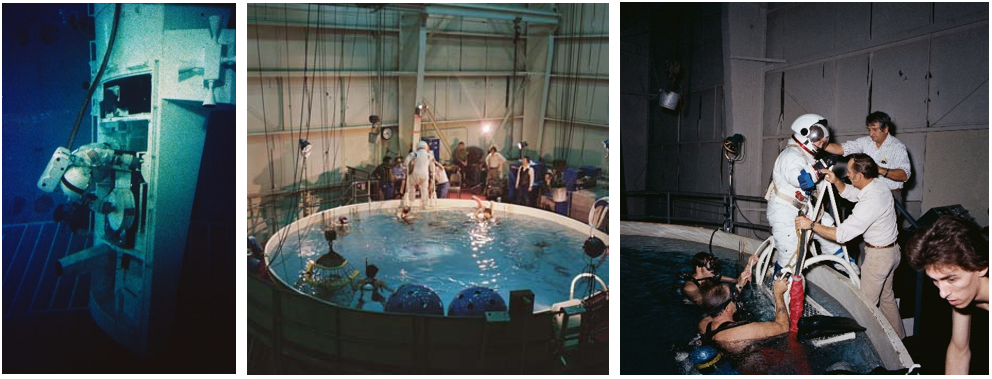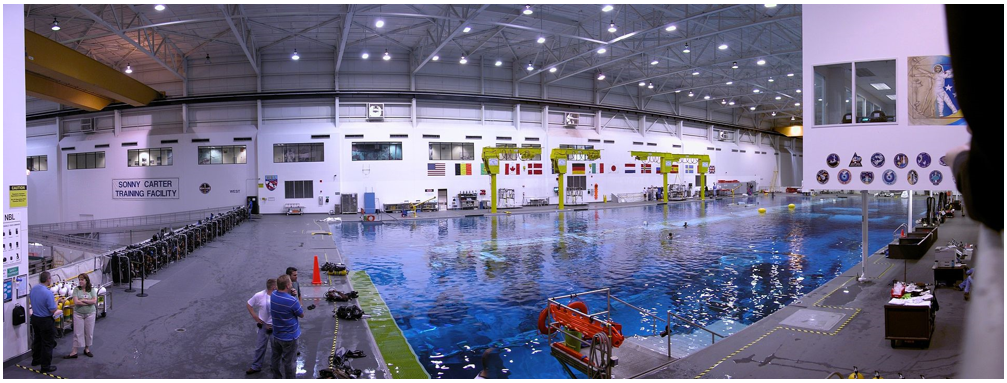Building on a Mission: Neutral Buoyancy Facilities for Spacewalk Training

This article is dedicated to Dr. John B. Charles, retired NASA scientist, manager, and space aficionado, with a unique expertise in the history of neutral buoyancy.
In 1961, the roles defined for the newly established Manned Spacecraft Center (MSC) in Houston, now NASA’s Johnson Space Center, included the training of astronauts. Among the tasks that astronauts needed to master to reach the Moon, spacewalking presented the biggest training challenge. Parabolic aircraft flights afforded only very brief periods of weightlessness, while other methods had even lower fidelity to an actual spacewalk. This training shortfall manifested itself when astronauts experienced significant difficulties during several Gemini missions when attempting complex spacewalk tasks. In 1966, NASA began to use neutral buoyancy as a higher-fidelity tool for spacewalk training, a method astronauts still rely on today. Beginning in 1967, MSC and then, later, JSC built ever-larger neutral buoyancy facilities as spacecraft grew larger and spacewalk tasks more complex.
 Using mock-ups of the Gemini and Agena spacecraft in the pool at the McDonogh School in Owings Mills, Maryland, astronaut Edwin E. “Buzz” Aldrin trains for his Gemini XII spacewalks in October 1966. Left: Aldrin at the rear of the Gemini spacecraft’s instrument compartment. Middle: Aldrin at the Agena adapter. Right: Aldrin exits the Gemini spacecraft. Credits: Environmental Research Associates
Using mock-ups of the Gemini and Agena spacecraft in the pool at the McDonogh School in Owings Mills, Maryland, astronaut Edwin E. “Buzz” Aldrin trains for his Gemini XII spacewalks in October 1966. Left: Aldrin at the rear of the Gemini spacecraft’s instrument compartment. Middle: Aldrin at the Agena adapter. Right: Aldrin exits the Gemini spacecraft. Credits: Environmental Research Associates
In preparation for lunar missions, astronauts needed to master working outside their spacecraft and, initially, training for spacewalks included parabolic aircraft flights that provided brief 30-second episodes of weightlessness, overhead suspension, and air-bearing tables. However, astronauts during the Gemini IX, X, and XI missions experienced significant difficulties during their spacewalks, and NASA sought better methods of training. In 1966, the agency assessed the benefits of neutral buoyancy training, in which space suited astronauts practiced spacewalking tasks in swimming pools. Astronaut M. Scott Carpenter provided a favorable assessment of training protocols established by Environmental Research Associates of Baltimore, Maryland, under contract to NASA’s Langley Research Center in Hampton, Virginia, using a swimming pool at the McDonogh School in Owings Mills, Maryland. Based on Carpenter’s positive assessment, in August 1966, MSC Director Robert R. Gilruth ordered the center to develop an in-house neutral buoyancy training capability.
On Sept. 12, 1966, with mock-ups of the Gemini and Agena target spacecraft placed in the McDonogh School’s pool, Edwin E. “Buzz” Aldrin became the first astronaut to use neutral buoyancy to train for his spacewalks on the upcoming Gemini XII mission. He returned in October for more training, less than one month before the actual mission, during which he successfully completed a then-record three spacewalks. Aldrin attributed the successes largely to his experiences in the pool.

Left: Astronaut M. Scott Carpenter demonstrating contingency external transfer from the Apollo Lunar Module to the Command Module in the Water Immersion Facility, or WIF, in Building 5 in 1967. Right: Apollo 11 astronaut Neil A. Armstrong’s suit is weighted to simulate lunar one-sixth gravity in the WIF in April 1969. Credits: NASA
In early 1967, workers installed a Water Immersion Facility (WIF), essentially a circular above-ground pool measuring 25 feet in diameter and 16 feet deep, in the east end of the northern wing of MSC’s Building 5, the Mission Simulator and Training Facility. Astronauts used the 82,000-gallon pool to train for spacewalks during the Apollo program, using mock-ups of the Lunar and Command Modules placed in the facility.
In April 1969, Neil A. Armstrong and Aldrin, as well as their backups, James A. Lovell and Fred W. Haise, used the WIF in a simulation of the Moon’s one-sixth gravity three months before the Apollo 11 Moon landing. Because of the large size of the Skylab space station, astronauts conducted spacewalk training for that program in the larger Neutral Buoyancy Simulator (NBS) at NASA’s Marshall Space Flight Center in Huntsville, Alabama. In 1978, the WIF was moved from Building 5 to an already existing 30-foot-by-16-foot pool in Building 260. Space shuttle astronauts used that tank for spacewalk training for about one year.
 Left: In the Building 5 WIF in 1972, Apollo 17 astronaut Ronald E. Evans practices the deep-space spacewalk to retrieve film canisters from the Apollo Service Module’s Scientific Instrument Module. Middle: Overall view of the WIF in Building 260 in 1978, with a suited subject about to enter the water. Right: In January 1979, then astronaut candidate Anna L. Fisher about to enter the WIF in Building 260 for spacewalk training. Credits: NASA
Left: In the Building 5 WIF in 1972, Apollo 17 astronaut Ronald E. Evans practices the deep-space spacewalk to retrieve film canisters from the Apollo Service Module’s Scientific Instrument Module. Middle: Overall view of the WIF in Building 260 in 1978, with a suited subject about to enter the water. Right: In January 1979, then astronaut candidate Anna L. Fisher about to enter the WIF in Building 260 for spacewalk training. Credits: NASA
The larger size of the space shuttle’s payload bay required a larger neutral buoyancy training facility and, in July 1978, workers began to construct the Weightless Environment Training Facility (WETF) in Building 29, the building that previously housed a human-rated centrifuge. The WETF, measuring 33 feet wide, 78 feet long, and 25 feet deep, became operational on Nov. 21, 1980, and astronauts used it for nearly all space shuttle spacewalk training until 1997. Some spacewalk training for the early Hubble Space Telescope servicing missions took place in the NBS at Marshall due to the instrument’s large size. In April 1996, during the Shuttle-Mir program and in preparation for space station operations, technicians tested a Russian Orlan spacesuit in the WETF for the first time.
 Stages of construction of the Weightless Environment Training Facility in Building 29 – November 1978, left, July 1980, and September 1980. Credits: NASA
Stages of construction of the Weightless Environment Training Facility in Building 29 – November 1978, left, July 1980, and September 1980. Credits: NASA

Left: STS-1 backup astronaut Richard H. Truly is lowered into the Weightless Environment Training Facility (WETF) in November 1980. Right: Astronaut Carl E. Walz practices space station assembly tasks in one of the last dives in the WETF in November 1996. Credits: NASA
In the late 1980s, NASA began to consider the need for an even larger neutral buoyancy training facility to handle the larger modules of Space Station Freedom that eventually became the International Space Station. NASA purchased an unused processing facility from the McDonnell Douglas Corp. near Ellington Field, a few miles north of Johnson. Workers began retrofitting the building with a pool 202 feet long and 102 feet wide with a depth of 40 feet. Construction of the Neutral Buoyancy Laboratory, or NBL, containing 6.2 million gallons of water, began in April 1995. That same month, NASA designated the building as the Sonny Carter Training Facility in honor of astronaut Manley L. “Sonny” Carter, who died in a plane crash in 1991. The first suited dives in the NBL, by astronauts Jerry L. Ross and Linda M. Godwin, took place in October 1996, and the facility was formally dedicated on May 19, 1997. Subsequent space shuttle and space station spacewalk training has taken place in the NBL.

Two views of early construction of the Neutral Buoyancy Laboratory at the Sonny Carter Training Facility in 1995. Credits: NASA

Overall view of the Neutral Buoyancy Laboratory at NASA’s Sonny Carter Training Facility. Credits: NASA
In addition to training space station crews for spacewalks to maintain and upgrade the orbital facility, astronauts use the NBL to test prototype spacewalk tools and techniques for future use on the space station and exploration missions to the Moon and beyond.

Left: Expedition 66 NASA astronaut Kayla Barron, left, and ESA (European Space Agency) astronaut Luca S. Parmitano as they are about to be lowered into the water in the Neutral Buoyancy Laboratory (NBL) in October 2020. Right: NASA astronauts Stephen G. Bowen, left, wearing an Extravehicular Mobility Unit spacesuit, and Zena M. Cardman in a prototype Z-2.5 spacesuit in the NBL in July 2021. Credits: NASA
To be continued …







